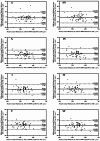Repeatability and agreement of AOCT-1000 M, RTVue XR and IOL master 500 in measuring corneal thickness mapping and axial length applying principle of optical coherence tomography
- PMID: 37990166
- PMCID: PMC10664477
- DOI: 10.1186/s12880-023-01147-7
Repeatability and agreement of AOCT-1000 M, RTVue XR and IOL master 500 in measuring corneal thickness mapping and axial length applying principle of optical coherence tomography
Abstract
Purpose: To evaluate the repeatability and agreement of Fourier-domain optical coherence tomography (AOCT-1000 M and RTVue XR) and partial coherence interferometry biometer (IOL Master 500) in measuring corneal thickness mapping and axial length respectively.
Methods: Corneal thickness was measured by AOCT-1000 M and RTVue XR. Axial lengths were measured by AOCT-1000 M and IOL Master 500. The repeatability and agreement of corneal thickness and axial length were calculated in two groups of devices. The intraclass correlation coefficient (ICC) was used to verify the repeatability of the device. The 95% confidence interval of the difference compared to the set cut-off value was used to verify the agreement between the two devices.
Results: A total of 60 subjects with 58 eyes were included. The central corneal thickness measured by AOCT-1000 M and RTVue XR were 504.46 ± 42.53 μm and 504.43 ± 42.89 μm respectively. The average difference between groups was 0.03 ± 4.58 μm, and the 95% confidence interval was (-1.17, 1.24), which was far less than the set threshold value of 15 μm (P < 0.001). Both RTVue XR and AOCT-1000 M had very good ICC values of central corneal thickness (0.998 and 0.994, respectively). The average axial lengths measured by AOCT-1000 M and IOL Master 500 were 24.28 ± 1.25 mm and 24.29 ± 1.26 mm respectively and the 95% confidence interval was (-0.02, 0.01), which was less than the set threshold value of 0.15 mm (P < 0.001). The ICC for both devices were 1.000.
Conclusion: Good repeatability and agreement were seen in measurements of central corneal thickness and axial length by AOCT-1000 M.
Keywords: AOCT-1000 M; Agreement; Axial length; Central corneal thickness; RTVue XR; Repeatability.
© 2023. The Author(s).
Conflict of interest statement
The authors declare no competing interests.
Figures





Similar articles
-
Evaluation of central corneal thickness measurement with RTVue spectral domain optical coherence tomography in normal subjects.Cornea. 2011 Feb;30(2):121-6. doi: 10.1097/ICO.0b013e3181e16c65. Cornea. 2011. PMID: 20885314
-
Repeatability and agreement of swept-source optical coherence tomography and partial coherence interferometry biometers in myopes.Clin Exp Optom. 2023 Sep;106(7):783-792. doi: 10.1080/08164622.2022.2152312. Epub 2022 Dec 12. Clin Exp Optom. 2023. PMID: 36508569
-
Comparison of Axial Length, Corneal Curvature, and Anterior Chamber Depth Measurements of 2 Recently Introduced Devices to a Known Biometer.Am J Ophthalmol. 2017 Jun;178:58-64. doi: 10.1016/j.ajo.2017.02.027. Epub 2017 Mar 2. Am J Ophthalmol. 2017. PMID: 28263734 Clinical Trial.
-
Intra-examiner repeatability and agreement of corneal pachymetry map measurement by time-domain and Fourier-domain optical coherence tomography.Graefes Arch Clin Exp Ophthalmol. 2010 Nov;248(11):1647-56. doi: 10.1007/s00417-010-1360-7. Epub 2010 Mar 30. Graefes Arch Clin Exp Ophthalmol. 2010. PMID: 20352443
-
Intrasession repeatability of pachymetry measurements with RTVue XR 100 optical coherence tomography in normal cornea.Saudi J Ophthalmol. 2017 Apr-Jun;31(2):65-68. doi: 10.1016/j.sjopt.2017.04.003. Epub 2017 Apr 9. Saudi J Ophthalmol. 2017. PMID: 28559715 Free PMC article.
Cited by
-
Comparison between spectral-domain optical coherence tomography-based and partial coherence interferometry-based biometry.Sci Rep. 2024 Nov 18;14(1):28440. doi: 10.1038/s41598-024-79679-3. Sci Rep. 2024. PMID: 39557992 Free PMC article.
-
Genome-Wide Association Analysis Identifies LILRB2 Gene for Pathological Myopia.Adv Sci (Weinh). 2024 Oct;11(40):e2308968. doi: 10.1002/advs.202308968. Epub 2024 Aug 29. Adv Sci (Weinh). 2024. PMID: 39207058 Free PMC article.
-
Repeatability and reproducibility of a new spectral-domain optical coherence tomography biometer and agreement with swept-source optical coherence tomography based biometer.Eye Vis (Lond). 2025 Feb 1;12(1):6. doi: 10.1186/s40662-024-00422-0. Eye Vis (Lond). 2025. PMID: 39891211 Free PMC article.
References
MeSH terms
LinkOut - more resources
Full Text Sources

